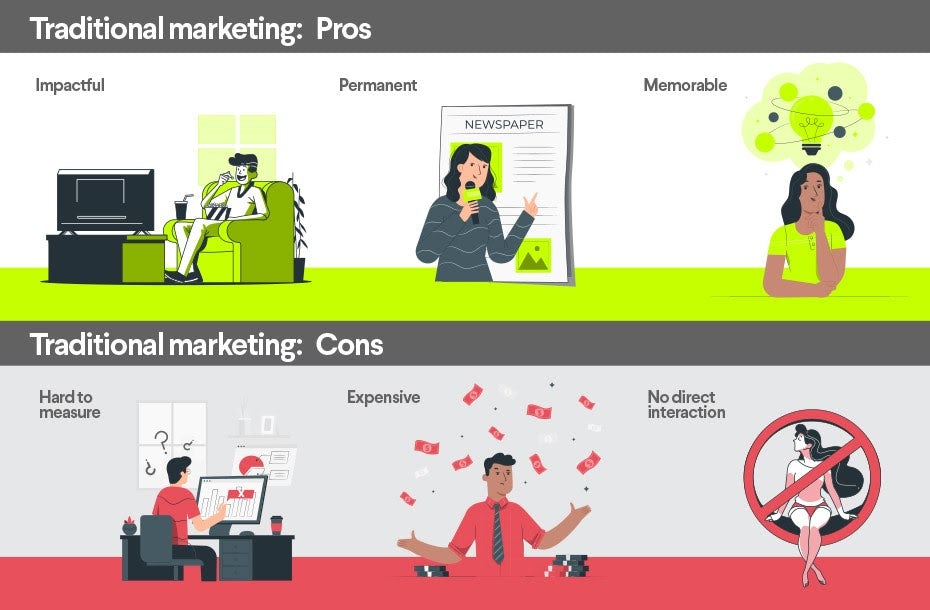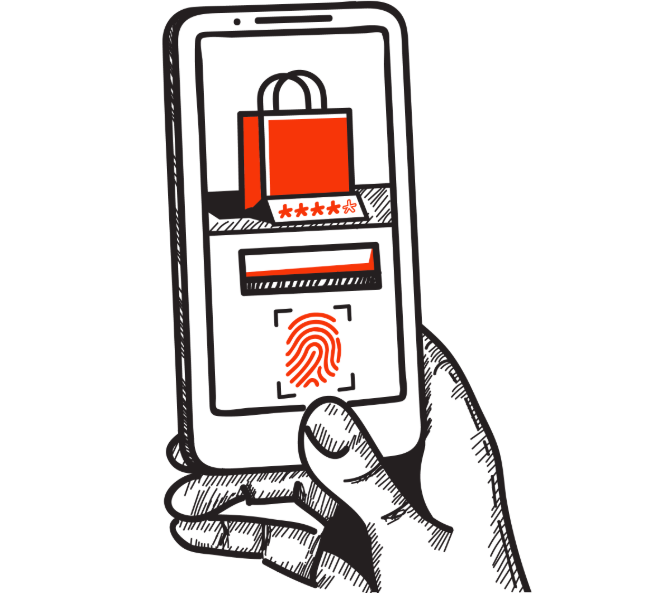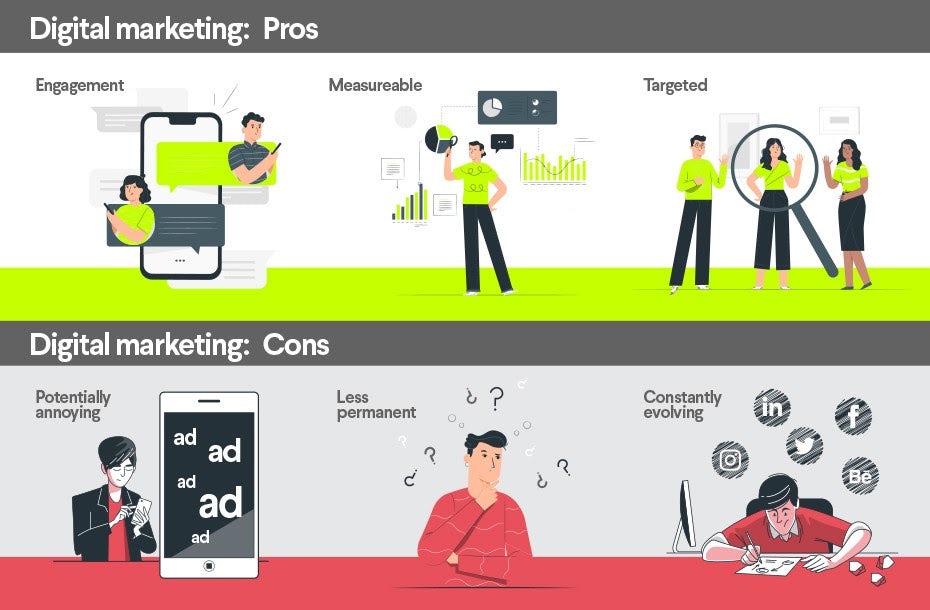Digital Marketing is using digital channels such as websites and social media as tools for marketing communication, where as, Traditional Marketing on the other hand involves traditional channels, like billboards and print media.
The main difference between digital and traditional marketing is the medium through which an audience encounters a marketing message. While traditional marketing uses traditional media like magazines and newspapers, digital marketing uses digital media, such as social media or websites.
Traditional Marketing doesn’t mean it’s old fashioned. It still plays an important role in people’s lives with the ever growing need to step out of the digital world. Digital Marketing is just as important as traditional if not even more so. Digital marketing uses every touch point of your daily use of the internet to reach you.

If you are google searching holiday ideas for your next weekend getaway, the chances are that soon after you will see a tailored sponsored ad from Sky Scanner.
Using the internet for several hours each day is a normal part of most people’s day to day life. Digital marketing just uses this to its advantage by cleverly weaving in marketing communications into every digital channel.
Traditional marketing: pros and cons
With the rise of social media, traditional marketing is often undervalued by marketers. However, traditional marketing still very much has a place in a consumer’s day to day life. If you have the budget to share your campaigns in magazines and prime time TV, your money could be well spent.

Traditional marketing channels include:
- Outdoor (Billboards, bus/taxi wraps, posters etc)
- Broadcasting (TV, Radio etc)
- Print (Magazines, newspapers etc)
- Direct Mail (catalogues etc)
- Telemarketing (Phone, text message)
- Window display and signs

Pros:
Impactful and easy to understand
A visually bold billboard or a striking TV commercial is a normal part of most people’s day to day lives. They’re easy to digest and often entertaining.
Printed marketing materials are more permanent
If you have an advert in an issue of The New York Times it will be there until the magazine is recycled. Which is great if the consumer is an avid collector.
More memorable
Seeing something in real life rather than on your phone is more likely to be remembered. The anticipation of the new Super-Bowl ads or a beautiful and impressive window display is more likely to stay in your mind than an instagram ad you’ll probably scroll past in seconds.
Cons:
More difficult to measure campaigns
There are ways to measure traditional marketing campaigns such as brand trackers but they are nowhere near as in depth or intelligent as the tools available for digital marketing.
Often expensive
If you’re a brand in its infancy chances are you don’t have the funds for a 4 page spread in Vogue. Many forms of traditional marketing will set you back a considerable amount.
No direct interaction with the consumer
Unlike social media marketing, you’re more or less in the dark about your audience’s reaction to your marketing efforts.
Digital marketing: pros and cons
However impactful traditional marketing is, we can’t forget that we are well and truly living in the internet age.

According to Research, “Internet users now make up 57% of the global population. On average, people spend 6 hours and 42 minutes online each day. By 2021, a projected 73% of all ecommerce sales will come from mobile.” That’s a huge amount of time and opportunity to do some clever digital marketing.
Digital marketing channels include:
- Social media (Facebook, Instagram etc)
- Website
- Content marketing
- Affiliate marketing
- Inbound marketing
- Email marketing
- PPC (pay per click
- SEM (Search engine marketing)

Pros:
More options for engagement
Through channels such as social media you can physically see what your audience think of your brand and marketing efforts. If your marketing has been shared, liked and had plenty of positive comments, you know you’re doing something right.
Easy to measure your campaigns
On the flipside to traditional marketing, the specifics of digital marketing tracking is exceptionally in depth. This makes your learnings extremely clear for your next round of marketing efforts.
Makes clever targeting possible
If you have the tools to specifically target a 29 year old female writer who loves Lizzo and drinking Guinness then surely you can also create perfectly tailored content.
Cons:
Digital ads can be deemed as annoying
Think about the moment you’re scrolling through your Facebook homepage and all you want to do is see what your old school friends are up to these days. Then you get the dreaded sponsored ad for something related to an embarrassing ailment you googled the night before. It’s sure to make you actively dislike the very brand doing the clever targeting.
Less permanent
Digital marketing efforts like Google ads, banners, promo emails or social media ads can have a fleeting, temporary character. They’re intangible and can easily be ignored. If your target audience keeps scrolling or clicks to the next page your ad will be gone from their screen.
Constantly evolves
To get the most out of your digital marketing efforts there is a lot to learn. Each channel usually requires its own specialist, from search engine marketing to social media, each channel requires a pro to get the best bang for your buck. However, a grass-roots social media marketing strategy is a great place to start. Have a look at our digital marketing strategy guide for some inspiration.
I hope this article was helpful for you to understand that how Digital Marketing is different from the Traditional Marketing but both are very important for any business to grow as per the requirement.
0 Comments